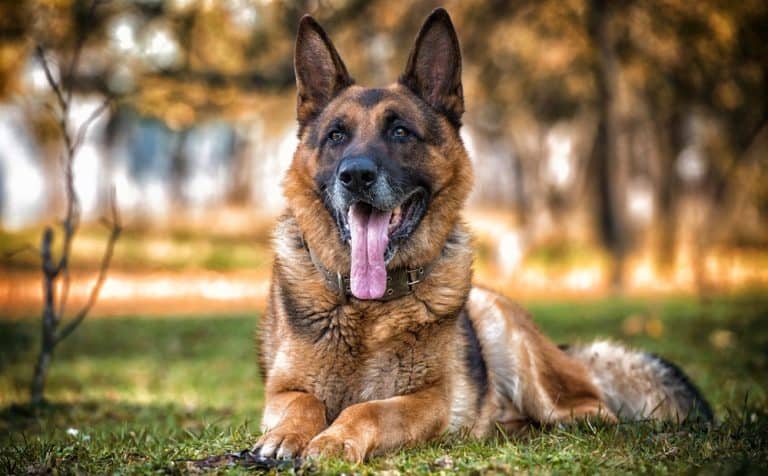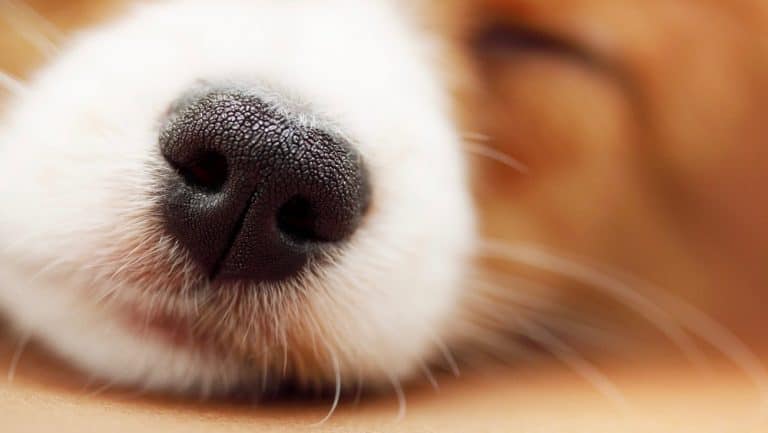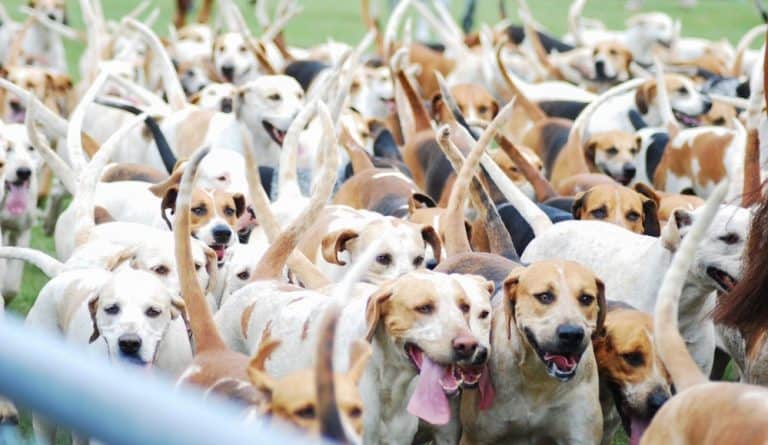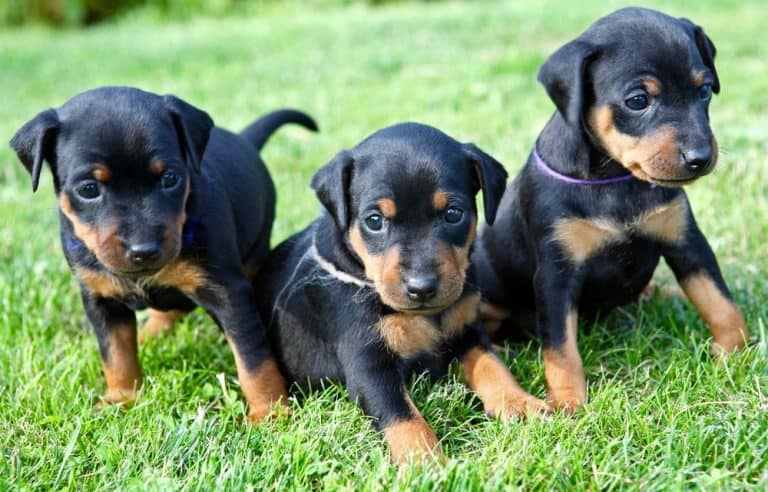Giant Schnauzer Growth Chart – Size & Weight Chart
Giant schnauzers are larger than standard schnauzers therefore a Giant Schnauzer growth chart will help you to track their specific growth as they age.
They are also more powerful with boldness and vigilance. Many owners appreciate their loyalty and intelligence which makes them great working dogs or simply companions.
Giant Schnauzers hail from Germany where they used to work in stockyards and butcher shops. They also have the job of driving cattle and sometimes guarding breweries.
This pure-blooded breed set itself apart from the other Schnauzer sizes.
They closely resemble standard and mini schnauzers, but they are much bigger as their name implies they are giants with imposing muscular builds.
Giant schnauzers are also double-coated with those famous fluffy beards and eyebrows. Today Giant Schnauzers continue to be working dogs in the military, police, and search and rescue.
When Is A Giant Schnauzer Fully Grown?
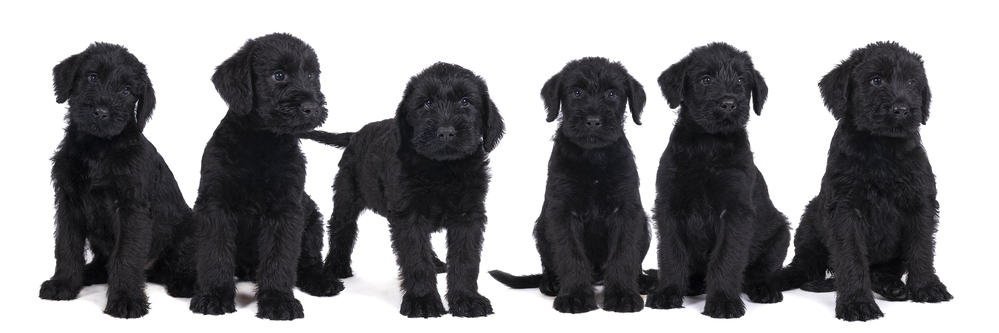
Even though every dog is different, Giant Schnauzers tend to reach their full height and weight when they are around 18 months old.
However, you will notice that their growth rates will slow down when they reach the one-year mark.
Many dogs continue to grow slowly after they reach 18 months and this usually continues until they are around three years old.
Please keep in mind that Giant Schnauzers are classified as a Giant breed, so they usually have more growing to do than smaller breeds.
Larger breeds are also known to have shorter life spans. Nevertheless, if you treat your Giant Schnauzers well in terms of nutrition and health you will be able to prolong his life.
In adulthood, female Giants schnauzers are usually about 23 to 26 inches tall end 55 to 75 lb on average. Alternatively, male Giant Schnauzers can be about 60 to 80 lb and stand at 25 to 28 inches.
Giant Schnauzer Weight Chart
This Giant Schnauzer growth chart is a useful way to monitor the growth of your Giant Schnauzer simply by taking a look at the figures and making comparisons with your actual dog.
The weight estimations that you will see are averages taken from Giant schnauzers.
Keep in mind that there are many reasons for the different growth rates that we see occurring within the dog breed. Your dog’s health hinges on many factors such as his exercise level, nutrition, and basic genetics.
Use the Giant Schnauzer weight chart to guide you along the journey of your dog’s development.
You may find that your dog’s age corresponds with the weight listed in the charge, or you may notice that it is not the same.
Don’t worry too much if your dog’s weight is slightly different from what is in the charts if there is no serious indication of him being sick.
If you are unsure you need to check with your veterinarian to make sure that he is in proper health.
Giant Schnauzer Puppy Weight Chart
| Age | Weight (kg) | Weight (lbs) |
|---|---|---|
| 2 Months | 8 kg | 17.5 lbs |
| 3 Months | 14 kg | 31 lbs |
| 4 Months | 22 kg | 48.5 lbs |
| 5 Months | 28 kg | 42 lbs |
| 6 Months | 34 kg | 75 lbs |
| 7 Months | 37 kg | 81.5 lbs |
| 8 Months | 39 kg | 86 lbs |
| 9 Months | 40 kg | 88 lbs |
| 10 Months | 41 kg | 90 lbs |
| 11 Months | 42 kg | 92.5 lbs |
| 12 Months | 42 kg | 92.5 lbs |
| 14 Months | 43 kg | 95 lbs |
| 16 Months | 44 kg | 97 lbs |
| 18 Months | 45 kg | 99 lbs |
Giant Schnauzer Growth Chart – What To Expect

Birth – 2 Weeks
Understand that your Giant Schnauzer will spend most of this time with his mother and other littermates because he needs her to tend to him in this period.
He needs his mother’s milk for the growth that will take place at this critical time. Proper nutrition for Giant Schnauzers is especially important since they are a giant breed and have a lot of growth to complete.
If for some reason you noticed that his mother has rejected him you will need to provide him with warmth and nourishment.
3 Weeks – 12 Weeks
Expect that your giant schnauzer will undergo a series of changes including the change from liquid to solid foods as well as the weaning from his mother’s milk.
He will also begin to have tougher teeth. As adult parents, you should ensure that this transition is seamless because his nourishment is important.

Make sure that the food he has given is soft enough for his teeth to handle. It should also be the correct size kibble.
At the end of this period, females usually weigh between 9 and 13 kg while males weigh between 10 and 17 kg.
4 Months – 9 Months
In this time, you can look for your giant schnauzer to be growing rapidly, but females are slightly smaller.
He will also have greater control of his muscles and be completely weaned gaining nourishment from solid foods. Ensure that you feed him foods that are high in protein. Also, make sure that he gets adequate exercise.
At 6 months female giant schnauzers should weigh between 18 and 24 kg while males should weigh between 19 and 40 kg.
10 Months – 18 Months
Your Giant Schnauzer should attain his full height when he is 12 months, but his growth is not complete as he will continue to gain muscle and also start to have a more adult temperament.
In other words, he will be less playful. Females at 12 months should weigh between 24 and 33 kg while males are likely to weigh between 26 and 45 kg
Adult
In adulthood, your giant schnauzer should have been properly socialized. The bigger giant schnauzers usually round out their growth at 19 months.
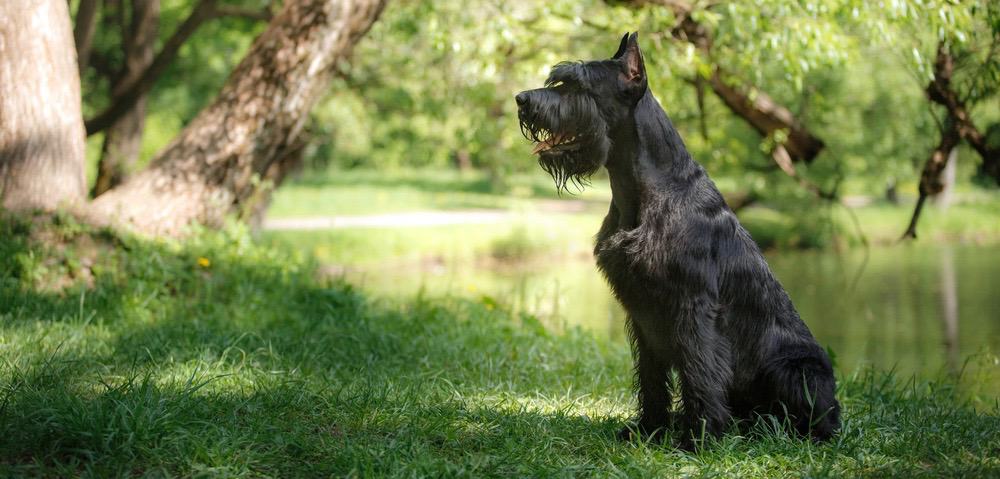
For females, this will be around the 16-month mark. Make sure that you adjust exercise levels, as well as food intake in adulthood because it will be different from puppies.
Keep in mind that schnauzers are working dogs, and they need adequate protein to be healthy.
How Big Do Giant Schnauzers Get?
Since giant schnauzers are larger dogs than most, the people who own them usually want to make sure they are comfortable by providing the proper accommodation for them.
This is why knowing how big they will get is so important. There are several methods to achieve this knowledge.
You can a look at the growth chart within this article for some idea of how big your Giant Schnauzer will get.
You can also look for information about their parents from their breeder to find out how big they were because schnauzers are usually the average size of their two parents.
Likewise, you can also look at his paws for some indication about his growth because when dogs have more growing to complete their paws tend to be a bit larger in proportion to their body size.
A DNA test can also help because it will map your dog’s genealogy and identify any other breeds that are within his bloodline which will affect his results.
Will Neutering/Spaying My Giant Schnauzer Affect His Growth?
When people have their giant schnauzers spayed too early, it can seriously affect their growth. Spaying and neutering have their place when it comes to your dog’s health because they can reduce the likelihood of certain diseases like cancers.
It can also remove the risk of unwanted pregnancies which can affect your dog if he is too young.
A dog’s time of heat is also when they typically leave your premises, and they get into trouble. He may even injure himself.
However, there are also downsides to spaying and neutering. Because the recovery time of these surgeries puts your dog in a delicate position and proper care needs to be taken. There is also the risk of the surgery itself.
Spaying and neutering affect your dog’s growth because it affects the hormones that are running through their system which affects their growth and heat cycle.
Giant Schnauzer Size Chart
Because Giant Schnauzers are different from their Schnauzer counterparts owners tend to watch their growth carefully.
To make sure that your giant schnauzer meets his important developmental milestones you should record his weight and height.
The withers are important for taking this measurement. The withers of a dog is just the highest point of his shoulder blades where his height measurement is taken.
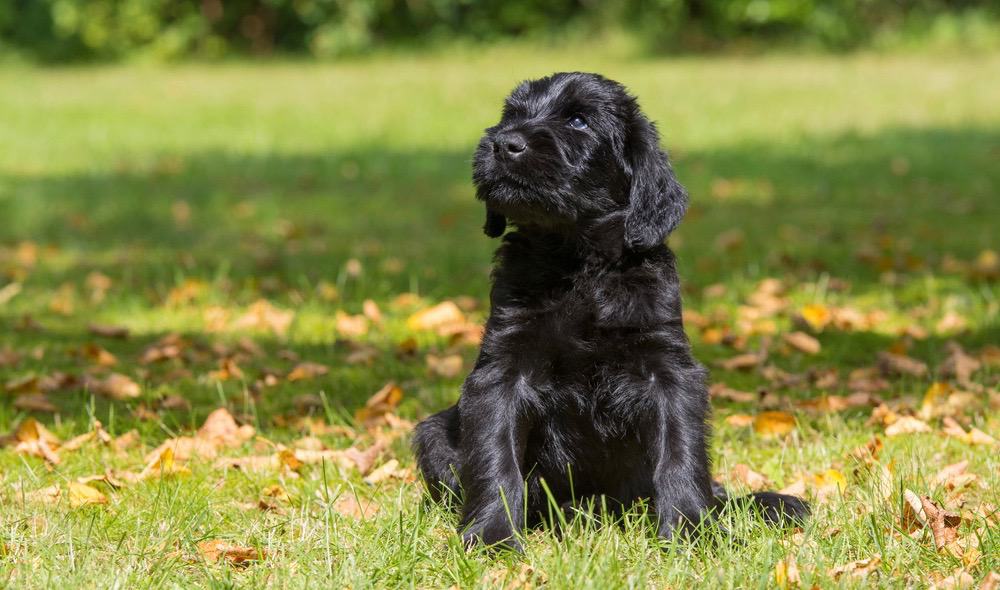
To measure your giant schnauzer all you have to do is drape a tape measure from the ground straight up to his withers and record this measurement. Make sure that your Giant Schnauzer is standing up straight.
German Shepherd vs Giant Schnauzer Size
There are key differences in German Shepherds and giant schnauzers like the fact the German Shepherds are classified as a large breed while Giant Schnauzers are viewed as Giants breeds.
They also share several similarities like the way both males of these breeds are slightly larger than their female counterparts.
German Shepherds typically have males weighing between 66 and 88 lb while females weigh between 49 and 79 lb. For height, German Shepherds have males standing up to 24 to 26 inches and females 22 to 24 inches.
With giant schnauzers, the males weigh between 62 and 105 lb while the females weigh between 55 and 75 lb. The males stand at 26 to 28 in and the females stand at 23 to 26 inches. Therefore, giant schnauzers are larger on average.
Factors That Affect Giant Schnauzer Growth
Genetics & Gender
Gender affects the growth and size of a giant schnauzer because males are known to be larger than females.
Also, spaying and neutering may affect them differently when it comes to growing. Genetics are also quite important since the growth rates and size are inherited from their parents.
Nutrition
Keep in mind that you should be feeding your Giant schnauzer based on his age and exercise level. Puppies do not have the same nutritional needs as adults or senior dogs.
He needs to be fed quality food with a lot of protein and fiber. He also needs healthy fats. This will also prolong his life which is important because he is a giant breed.
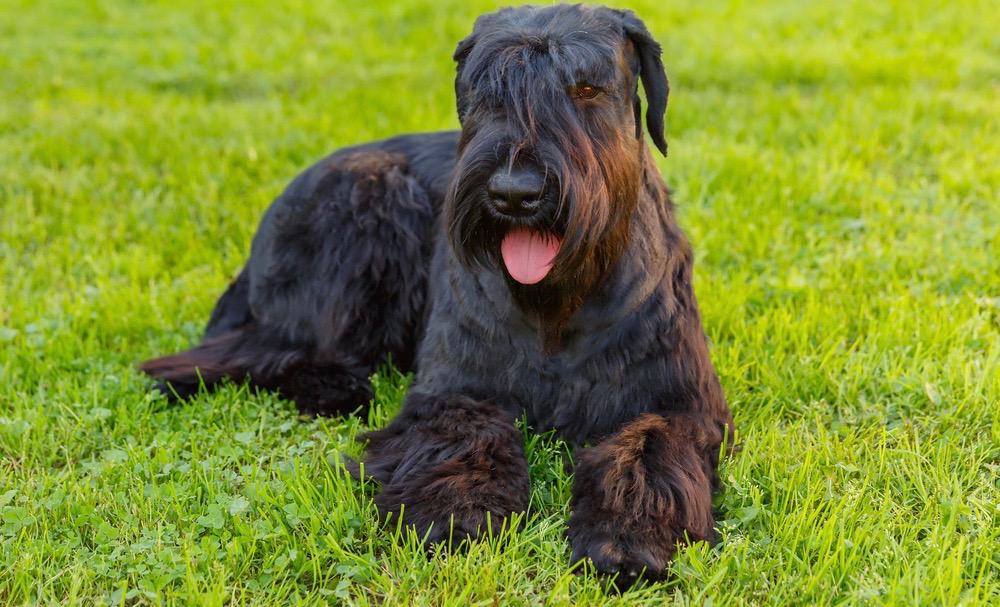
Give him 3 – 4 cups of healthy food, and you can’t divide this into two (2) meals throughout the day.
Physical Activity & Health
Giant schnauzers are energetic and need at least two walks per day that run for at least 30 to 60 minutes. You can also play with them in your yard for this amount of time.
They need mental stimulation and adequate exercise otherwise they can become destructive. Proper amounts of exercise will also have them develop strong bones and muscles. It also has the added benefit of prolonging their lives.
What If My Giant Schnauzer Is Not The Right Weight
Since growth can be determined by several factors it may be difficult to know the size to see if your Giant Schnauzer is the right weight.
The first thing you should understand is that every individual dog is different so even when estimations are given you should leave some room for error.
As an owner, you could use a BCS – body condition score to gauge your dog’s growth. It is the animal equivalent of a human BMI.
The BCS looks at the profile and aerial view of your dog for certain key factors that affect each breed differently. For giant schnauzers, you can look at his profile for a clear view of his ribs.
If you can see his ribs clearly and feel them without a layer of fat, then you know that he is too thin.
Make sure that you give him lots of protein healthy fats as well as fiber. Additionally, you should check with his veterinarian for further information about his state of health so that you can take care of him properly.
Giant Schnauzer Genetics And Common Health Problems
For the most part, giant schnauzers tend to be healthy, although they have a shorter life span than many breeds. This is mainly due to their size.
That said, it is important to note that Giant Schnauzers have one of the longest lifespans of giant breeds with many of them living up to 14 years.
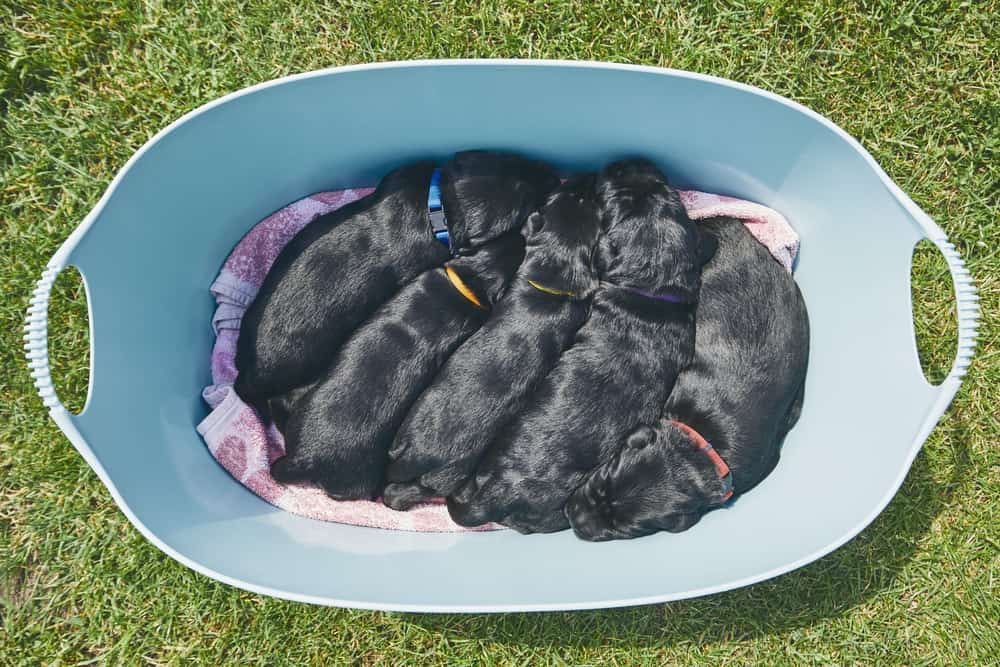
However, many conditions plague them, and treating these conditions can help you to prolong the life of your dog.
These are hip dysplasia Osteochondrosis Dissecans (OCD), and Autoimmune Thyroiditis.
Although they may suffer from diseases many of them do not. However, having information about them can help you to make an early diagnosis.
Final Words
Giant schnauzers are double-coated, but they are not overly fluffy because their fur is about medium in length.
However, you still need to ensure that they are properly groomed especially their eyebrows and their beard. Grooming is also a good way to bond with your dog and form a deeper connection.
Make sure that you brush his coat at least once per week and keep his head trim.
Additionally, he should be groomed at least once per month which includes clear bang his heirs and brushing his teeth. Make sure that he starts training at a young age.

